Drake Institute Recommended Readings
The Drake Institute of Teaching and Learning and its partners recognize that time for self-reflection is essential to enhancing teaching effectiveness and refining the learning experiences we offer our students. The UITL Reading List comprises texts you might find valuable whether you are designing a new course, redesigning a course, or considering how to better support your students using evidence-based instructional approaches.
We have categorized recommendations to assist you in finding resources that match your areas of interest from "Design for Learning" to "Supporting Instruction" and "Considering Course Impact." You can begin your exploration below or move directly to the resources that best fit your needs.
Designing for Learning
We have selected these reading recommendations to help you reflect on your teaching philosophy, the ways your students learn best, and how you design learning activities, materials, and courses.
Staff Picks
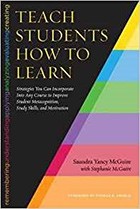 McGuire, S. Y., & McGuire, S. (2015). Teach students how to learn: Strategies you can incorporate into any course to improve student metacognition, study skills, and motivation.
McGuire, S. Y., & McGuire, S. (2015). Teach students how to learn: Strategies you can incorporate into any course to improve student metacognition, study skills, and motivation.
 Lang, J.M. (2016). Small teaching: Everyday lessons from the science of learning. San Francisco, CA: Jossey-Bass.
Lang, J.M. (2016). Small teaching: Everyday lessons from the science of learning. San Francisco, CA: Jossey-Bass.
 Fink, L.D. (2003). Creating significant learning experiences: An integrated approaches to designing college courses. San Francisco, CA: Jossey-Bass.
Fink, L.D. (2003). Creating significant learning experiences: An integrated approaches to designing college courses. San Francisco, CA: Jossey-Bass.
Integrated course design; Fink, L.D., & IDEA Center. (2005).
The 21st-century syllabus: Tips for putting andragogy into practice; Lund, D. K., & Fornaciari, C. J. (October 01, 2014). Journal of Management Education.
Principles of instruction: Research-based strategies that all teachers should know; Rosenshine, B. (January 01, 2012). American Educator.
Books
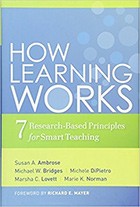 Ambrose, S.A., M.W. Bridges, M.C. Lovett, M. DiPietro, M.K. Norman. (2010). How learning works: 7 research-based principles for smart teaching. San Francisco, CA: Jossey-Bass.
Ambrose, S.A., M.W. Bridges, M.C. Lovett, M. DiPietro, M.K. Norman. (2010). How learning works: 7 research-based principles for smart teaching. San Francisco, CA: Jossey-Bass.
How Learning Works bridges learning-based research evidence to practices for improving college teaching. The authors specifically address seven learning principles, including prior student knowledge, student organization of knowledge, student motivation, mastery of skills, the influence of practice and feedback, the intersection of emotional, social and intellectual development as well as self-directed learning.
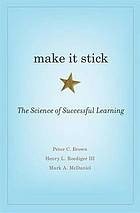 Brown, P.C., H.L. Roediger III & M.A. McDaniel (2014). Make it stick: The science of successful learning. Cambridge, MA: The Bellknap Press of Harvard University Press.
Brown, P.C., H.L. Roediger III & M.A. McDaniel (2014). Make it stick: The science of successful learning. Cambridge, MA: The Bellknap Press of Harvard University Press.
Make It Stick debunks common myths around best learning practices, and proposes that a long-term, repetitive process makes learning more effective. The authors explain that learning should be effortful and focused on the long-term retrieval of information built on prior knowledge, rather than the "cramming" or intensive "practice makes perfect" method.
 Cavanagh, S.R. (2016). The spark of learning: Energizing the college classroom with the science of emotion. Morgantown: West Virginia University Press.
Cavanagh, S.R. (2016). The spark of learning: Energizing the college classroom with the science of emotion. Morgantown: West Virginia University Press.
In friendly, readable prose, Sarah Rose Cavanagh argues that if you as an educator want to capture your students' attention, harness their working memory, bolster their long-term retention, and enhance their motivation, you should consider the emotional impact of your teaching style and course design. To make this argument, she brings to bear a wide range of evidence from the study of education, psychology, and neuroscience, and she provides practical examples of successful classroom activities from a variety of disciplines in secondary and higher education.
 Fink, L.D. (2003). Creating significant learning experiences: An integrated approaches to designing college courses. San Francisco, CA: Jossey-Bass.
Fink, L.D. (2003). Creating significant learning experiences: An integrated approaches to designing college courses. San Francisco, CA: Jossey-Bass.
L. Dee Fink writes this book in response to two main problems he has observed on college campuses: 1. the majority of learning goals focus on basic memorization; 2. despite a strong push for active learning in college classrooms, many instructors do not engage students beyond standard lectures and intermittent discussion.
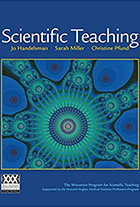 Handelsman, J., Miller, S., & Pfund, C. (2007). Scientific Teaching. New York: W.H. Freeman.
Handelsman, J., Miller, S., & Pfund, C. (2007). Scientific Teaching. New York: W.H. Freeman.
Seasoned classroom veterans, pre-tenured faculty, and neophyte teaching assistants alike will find this book invaluable. The authors of this book have distilled key findings from education, learning, and cognitive psychology and translated them into six chapters of digestible research points and practical classroom examples. Scientific Teaching is not a prescription for better teaching. Rather, it encourages the reader to approach teaching in a way that captures the spirit and rigor of scientific research and to contribute to transforming how students learn science.
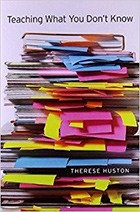 Hurston, T. (2009). Teaching what you don't know. Cambridge, MA: Harvard University Press.
Hurston, T. (2009). Teaching what you don't know. Cambridge, MA: Harvard University Press.
Therese Hurston, the Founding Director for the Center for Excellence in Teaching and Learning at Seattle University, wrote this book based on numerous interviews she conducted with university faculty across a variety of disciplines. In her interviews, she spoke with faculty members about the growing need to teach outside of one's academic expertise and how professors often feel only about "10 minutes ahead" of students in preparing for new classes.
 Lang, J.M. (2016). Small teaching: Everyday lessons from the science of learning. San Francisco, CA: Jossey-Bass.
Lang, J.M. (2016). Small teaching: Everyday lessons from the science of learning. San Francisco, CA: Jossey-Bass.
James Lang, English professor and director of the Center for Teaching Excellence at Assumption College, explains how small but powerful modifications in course design and teaching can yield positive results in higher ed settings. He groups these modifications into three broader categories: 5-10 minute classroom activities; one-time course interventions; and small modifications in course design or communication.
 McGuire, S. Y., & McGuire, S. (2015). Teach students how to learn: Strategies you can incorporate into any course to improve student metacognition, study skills, and motivation.
McGuire, S. Y., & McGuire, S. (2015). Teach students how to learn: Strategies you can incorporate into any course to improve student metacognition, study skills, and motivation.
For over a decade Saundra McGuire has been acclaimed for her presentations and workshops on metacognition and student learning because the tools and strategies she has shared have enabled faculty to facilitate dramatic improvements in student learning and success. The methods she proposes do not require restructuring courses, nor indeed an inordinate amount of time to teach; they can often be accomplished in a single session, transforming students from memorizers and regurgitators to students who begin to think critically and take responsibility for their own learning.
 Palmer, P. J. (2007). The courage to teach: Exploring the inner landscape of a teacher's life. San Francisco, CA: Jossey-Bass.
Palmer, P. J. (2007). The courage to teach: Exploring the inner landscape of a teacher's life. San Francisco, CA: Jossey-Bass.
While much scholarship on teaching and learning focuses on how students learn, Parker J. Palmer, renowned author, activist and founder of the Center for College and Renewal, writes The Courage to Teach in order to explore how the character of the teacher, and the inner life of the teacher, are crucial elements in the teaching and learning process.
 Schwartz, D.L., J.M. Tang, & K.P. Blair. (2016). The ABCs of how we learn. New York: Norton.
Schwartz, D.L., J.M. Tang, & K.P. Blair. (2016). The ABCs of how we learn. New York: Norton.
An explosive growth in research on how people learn has revealed many ways to improve teaching and catalyze learning at all ages. The purpose of The ABCs of How We Learn is to present this new science of learning so that educators can creatively translate the science into exceptional practice. Based on a popular Stanford University course, this book uses a novel format that is suitable as both a textbook and a popular read. With everyday language, engaging examples, a sense of humor, and solid evidence, it describes 26 unique ways that students learn.
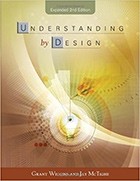 Wiggins, G. and J. McTighe. (2005). Understanding by design (2nd edition). Upper Saddle River, NJ: Pearson Education, Inc.
Wiggins, G. and J. McTighe. (2005). Understanding by design (2nd edition). Upper Saddle River, NJ: Pearson Education, Inc.
Grant Wiggins and Jay McTighe introduce the concept of backward design to curriculum development in Understanding by Design as the "UbD model" of backward design. The UbD model encourages instructors to begin their course planning with learning outcomes in mind and to then fit the lectures, activities and materials around these desired learning outcomes.
Articles
Allen, D., and K. Tanner. (2005). Infusing Active Learning into the Large-enrollment biology Class: Seven Strategies, from Simple to Complex. Cell Biology Education 4:262-268.
"Educators who have addressed the multitude of issues that underlie implementation of active-learning strategies in large-enrollment settings are conscientiously spreading the word to the science education community by presenting at conferences or publishing in science education journals. In this article, the authors focus on the large-class setting, providing an overview of tried-and-true approaches for incorporating active learning, ranging from the simple to complex. "
Bridging the pathway from instruction to research.
Batzli, J. M., Ebert-May, D., & Hodder, J. (2006). Bridging the pathway from instruction to research. Frontiers in Ecology and the Environment, 4(2), 105-107.
"The challenge for many faculty who have changed their courses is to determine if the innovations actually improve student learning. This leads some faculty towards research models that require empirical evidence based on student assessment data. Here we describe a framework for research on scientific teaching."
An empirical study comparing gamification and social networking on e-learning
de-Marcos, L., Domínguez, A., Saenz-de-Navarrete, J., & Pagés, C. (June 01, 2014). An empirical study comparing gamification and social networking on e-learning. Computers & Education, 75, 82-91.
"While social networking has already demonstrated its efficiency in e-learning, gamification, which is the use of game-thinking and playful design in non-game contexts, has only shown its potential as a motivational tool. This paper presents the results of testing both social networking and gamification in an undergraduate course, comparing them in terms their effect on students' academic achievement, participation and attitude."
Fink, L.D., & IDEA Center. (2005). Integrated course design. IDEA Paper #42. IDEA Center, Inc. 301 South Fourth Street Suite 200, Manhattan, KS 66502. Tel: 800-255-2757; Tel: 785-320-2400; e-mail: info@IDEAedu.org; Web site: http://ideaedu.org.
This paper outlines the key ideas and components of the model presented in L. Dee Fink's book, Creating Significant Learning Experiences: An Integrated Approach to Designing College Courses.
Active learning increases student performance in science, engineering, and mathematics.
Freeman, S., Eddy, S. L., McDonough, M., Smith, M. K., Okoroafor, N., Jordt, H., & Wenderoth, M. P. (2014). Active learning increases student performance in science, engineering, and mathematics. Proceedings of the National Academy of Sciences, 111(23), 8410-8415.
"This is the largest and most comprehensive metaanalysis of undergraduate STEM education published to date. The results raise questions about the continued use of traditional lecturing as a control in research studies, and support active learning as the preferred, empirically validated teaching practice in regular classrooms."
The 21st-century syllabus: Tips for putting andragogy into practice
Lund, D. K., & Fornaciari, C. J. (October 01, 2014). The 21st-century syllabus: Tips for putting andragogy into practice. Journal of Management Education, 38, 5, 724-732.
"Readers (are offered) seven concrete and practical tips to help them develop their own andragogically-inspired syllabi. We expect that instructors could adapt some, or all, of these tips in unique and interesting ways to best suit their own teaching styles and student learning objectives."
Principles of instruction: Research-based strategies that all teachers should know
Rosenshine, B. (January 01, 2012). Principles of instruction: Research-based strategies that all teachers should know. (Report). American Educator, 36, 1.
This article presents 10 research-based principles of instruction, along with suggestions for classroom practice. These principles come from three sources: (a) research in cognitive science, (b) research on master teachers, and (c) research on cognitive supports.
Preparing an effective syllabus: Current best practices
Slattery, J. M., & Carlson, J. F. (December 07, 2005). Preparing an effective syllabus: Current best practices. College Teaching, 53, 4, 159.
"Syllabi can be useful in engaging students and creating an effective classroom atmosphere, yet discussions of their effective use rarely appear. In light of current research and theory on syllabi, we review their typical uses (structural, motivational, and evidentiary), commonly included components, and attributes that positively impact the teaching and learning process."
Supporting Instruction
These texts present you with evidence-based instructional approaches you can implement in a variety of courses whether you teach large enrollment lectures or small graduate seminars, undergraduates or professional program students, face-to-face or online.
Staff Picks
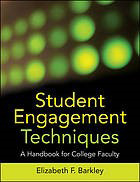 Barkley, E. F. (2010). Student engagement techniques: A handbook for college faculty. San Francisco: Jossey-Bass.
Barkley, E. F. (2010). Student engagement techniques: A handbook for college faculty. San Francisco: Jossey-Bass.
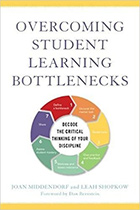 Middendorf, J. K., & Shopkow, L. (2017). Overcoming student learning bottlenecks: Decode the critical thinking of your discipline.
Middendorf, J. K., & Shopkow, L. (2017). Overcoming student learning bottlenecks: Decode the critical thinking of your discipline.
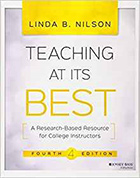 Nilson, L. B. (2016). Teaching at its best: A research-based resource for college instructors.
Nilson, L. B. (2016). Teaching at its best: A research-based resource for college instructors.
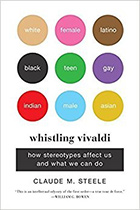 Steele, Claude M. (2010). Whistling vivaldi: How stereotypes affect us and what we can do. New York, NY: W.W. Norton & Company.
Steele, Claude M. (2010). Whistling vivaldi: How stereotypes affect us and what we can do. New York, NY: W.W. Norton & Company.
Energizing learning: The instructional power of conflict; Johnson, D. W., & Johnson, R. T. (January 01, 2009). Educational Researcher.
Ten (updated) principles of academic integrity: How faculty can foster student honesty; McCabe, D., & Pavela, G. (May 01, 2004). Change: the Magazine of Higher Learning.
Active learning strategies in face-to-face courses; Millis, B. J., & IDEA Center. (2012).
Facilitating group discussions: Understanding group development and dynamics; Takayama, K. (2009-10). Essays on teaching excellence: Toward the best in the academy.
Books
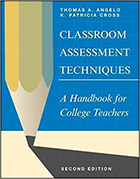 Angelo, T. A., & Cross, K. P. (1993). Classroom assessment techniques: A handbook for college teachers. San Francisco: Jossey-Bass Publishers.
Angelo, T. A., & Cross, K. P. (1993). Classroom assessment techniques: A handbook for college teachers. San Francisco: Jossey-Bass Publishers.
This revised and greatly expanded edition of the 1988 handbook offers teachers at all levels of experience detailed, how-to advice on classroom assessment from what it is and how it works to planning, implementing, and analyzing assessment projects. The authors illustrate their approach through twelve case studies that detail the real-life classroom experiences of teachers carrying out successful classroom assessment projects.
 Barkley, E. F. (2010). Student engagement techniques: A handbook for college faculty. San Francisco: Jossey-Bass.
Barkley, E. F. (2010). Student engagement techniques: A handbook for college faculty. San Francisco: Jossey-Bass.
Student Engagement Techniques is a comprehensive resource that offers college teachers a dynamic model for engaging students and includes over one hundred tips, strategies, and techniques that have been proven to help teachers from a wide variety of disciplines and institutions motivate and connect with their students. The ready-to-use format shows how to apply each of the book's techniques in the classroom and includes purpose, preparation, procedures, examples, online implementation, variations and extensions, observations and advice, and key resources.
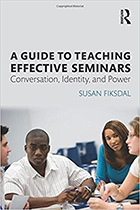 Fiksdal, S.R. (2014). A guide to teaching effective seminars: Conversation, identity and power. New York, NY: Routledge.
Fiksdal, S.R. (2014). A guide to teaching effective seminars: Conversation, identity and power. New York, NY: Routledge.
Susan Fiksdal, a linguistics professor at The Evergreen State College, utilizes her training as a sociolinguist to analyze seminars and provide best practices for instructors use in seminars. Her work considers how students find their voices in seminar spaces; she explores both how students develop their own academic voices as well as how students literally enter their voices into discussion-style seminars.
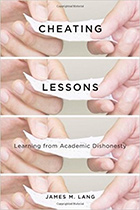 Lang, J.M. (2013). Cheating lessons: Learning from academic dishonesty. Cambridge, MA: Harvard University Press.
Lang, J.M. (2013). Cheating lessons: Learning from academic dishonesty. Cambridge, MA: Harvard University Press.
James Lang, English professor and director of the Center for Teaching Excellence at Assumption College, geared this book to academic faculty as well as administrators who support teaching faculty. His research focuses on academic dishonesty as an inappropriate response to a specific learning environment, rather than a tendency of some individual students.
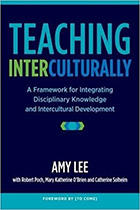 Lee, A., et. al. (2017). Teaching interculturally: A framework for integrating disciplinary knowledge and intercultural development. Sterling, VA: Stylus Publishing.
Lee, A., et. al. (2017). Teaching interculturally: A framework for integrating disciplinary knowledge and intercultural development. Sterling, VA: Stylus Publishing.
Amy Lee, Robert Poch, Mary Katherine O'Brien and Catherine Solheim wrote this book to lay out a pedagogical framework for allowing a diversity of voices and experiences to emerge in the classroom. The basis of their intercultural pedagogy holds that all students bring specific experiences and backgrounds to the class that informs their work and their learning. By implementing certain practices in the classroom, instructors can draw on these diverse perspectives to create an inclusive, student-centered learning environment.
 Middendorf, J. K., & Shopkow, L. (2017). Overcoming student learning bottlenecks: Decode the critical thinking of your discipline.
Middendorf, J. K., & Shopkow, L. (2017). Overcoming student learning bottlenecks: Decode the critical thinking of your discipline.
Decoding the Disciplines is a widely-used and proven methodology that prompts teachers to identify the bottlenecks – the places where students get stuck – that impede learners' paths to expert thinking in a discipline. The process is based on recognizing the gap between novice learning and expert thinking, and uncovering tacit knowledge that may not be made manifest in teaching. Through "decoding," implicit expert knowledge can be turned into explicit mental tasks, and made available to students. This book presents a seven-step process for uncovering bottlenecks and determining the most effective way to enable students to surmount them.
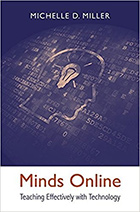 Miller, Michelle D. (2014). Minds online: Teaching effectively with technology. Boston, MA: Harvard University Press.
Miller, Michelle D. (2014). Minds online: Teaching effectively with technology. Boston, MA: Harvard University Press.
Michelle D. Miller, Co-Director of the First Year Learning Initiative and Professor of Psychology at Northern Arizona University, provides strategic ways for university faculty and instructors to align classroom technology with key principles of human cognition, namely attention, memory and thinking. Minds Online, written in a conversational and accessible tone, begins with a discussion of the impact of technology in contemporary higher education settings. Miller then dedicates specific chapters to attention, memory and thinking.
 Nilson, L. B. (2016). Teaching at its best: A research-based resource for college instructors.
Nilson, L. B. (2016). Teaching at its best: A research-based resource for college instructors.
Teaching at Its Best is the bestselling, research-based toolbox for college instructors at any level, in any higher education setting. Packed with practical guidance, proven techniques, and expert perspectives, this book helps instructors improve student learning both face-to-face and online. This new fourth edition features five new chapters on building critical thinking into course design, creating a welcoming classroom environment, helping students learn how to learn, giving and receiving feedback, and teaching in multiple modes, along with the latest research and new questions to facilitate faculty discussion.
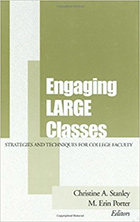 Stanley, Christine A. & M. Erin Porter. (2002). Engaging large classes: Strategies and techniques for college faculty. Boston, MA: Anker Pub Co.
Stanley, Christine A. & M. Erin Porter. (2002). Engaging large classes: Strategies and techniques for college faculty. Boston, MA: Anker Pub Co.
Christine A. Stanley and M. Erin Porter explain that with many universities forming larger classroom sizes, instructors may find themselves teaching classes of between 100-500 students, depending on their institutional size. Their volume aims to provide research-based methods as well as instructor advice about how to effectively teach and promote learning in a large classroom setting. Stanley and Porter, respectively a professor of Higher Education and a professor of Speech Communication, edited the volume and curated articles from instructors in over seventeen disciplines to provide a broad range of examples about managing large classes.
 Steele, Claude M. (2010). Whistling vivaldi: How stereotypes affect us and what we can do. New York, NY: W.W. Norton & Company.
Steele, Claude M. (2010). Whistling vivaldi: How stereotypes affect us and what we can do. New York, NY: W.W. Norton & Company.
In Whistling Vivaldi, Claude M. Steele, a social psychologist, explores how the concept of stereotype threat relates to minority performance in university settings. For Steele, stereotype threat is the ways in which people are internally guided and restricted by stereotypes about their particular demographics and identities.
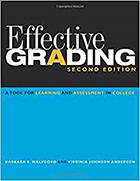 Walvoord, B.E.F., & Anderson, V. J. (2010). Effective grading: A tool for learning and assessment in college.
Walvoord, B.E.F., & Anderson, V. J. (2010). Effective grading: A tool for learning and assessment in college.
The second edition of Effective Grading — the book that has become a classic in the field — provides a proven hands-on guide for evaluating student work and offers an in-depth examination of the link between teaching and grading. Authors Barbara E. Walvoord and Virginia Johnson Anderson explain that grades are not isolated artifacts but part of a process that, when integrated with course objectives, provides rich information about student learning, as well as being a tool for learning itself. The authors show how the grading process can be used for broader assessment objectives, such as curriculum and institutional assessment.
Articles
Corrigan, H., & Craciun, G. (June 06, 2013). Asking the right questions: Using student-written exams as an innovative approach to learning and evaluation. Marketing Education Review, 23, 1, 31-35.
"Most students are concerned about grades and often have negative attitudes toward testing. Students perceive traditional instructor-written exams as irrelevant and autocratic, leading to lower trust in teaching and evaluation methods and decreased motivation to learn. This paper discusses a new approach, the student-written exam, which is a take-home assessment where each student writes and answers his or her own exam questions."
Peer instruction: Ten years of experience and results
Crouch, C. H., & Mazur, E. (September 01, 2001). Peer instruction: Ten years of experience and results. American Journal of Physics, 69, 9, 970-77.
"Presents data from 10 years of teaching using Peer Instruction (PI) in calculus- and algebra-based introductory physics courses for non-majors. Results indicate increased mastery of both conceptual reasoning and quantitative problem solving upon implementing PI. Discusses ways to improve the implementation of PI."
Student perceptions of classroom engagement and learning using iPads
Diemer, T., Fernandez, E., & Streepey, J. (2013). Student perceptions of classroom engagement and learning using iPads. Journal of Teaching and Learning with Technology, 1(2), 13-25.
"This paper reports on a multidisciplinary assessment of student perceptions of engagement and learning using iPads. Student reactions following single and multiple classroom activities using iPads were measured via a survey asking them to rate their learning and engagement using a 5-point Likert scale. Responses to the questions were grouped into thematic categories of Perceived Learning and Perceived Engagement. Students who reported a high level of engagement while using iPads reported a high level of learning as well."
Energizing learning: The instructional power of conflict
Johnson, D. W., & Johnson, R. T. (January 01, 2009). Energizing learning: The instructional power of conflict. Educational Researcher, 38, 3.
"Although intellectual conflict may be an important instructional tool (because of its potential constructive outcomes), conflict is rarely structured in instructional situations (because of its potential destructive outcomes). Many educators may be apprehensive about instigating intellectual conflict among students because of the lack of operational procedures to guide them. Ideally, operational procedures should be based on social science theory that is validated by research. Constructive controversy is an instructional procedure that is designed to create intellectual conflict among students and that meets these criteria. The authors of this article summarize the theory underlying constructive controversy and review the results of their meta-analysis of the validating research. The positive outcomes indicate that intellectual conflict can have important and positive effects on student learning and well-being."
Ten (updated) principles of academic integrity: How faculty can foster student honesty
McCabe, D., & Pavela, G. (May 01, 2004). Ten (updated) principles of academic integrity: How faculty can foster student honesty. Change: the Magazine of Higher Learning, 36, 3, 10-15.
"The writers present an updated version of their original 'Principles of Academic Integrity for Faculty' that builds on the many things they have learned over the past five years in conversations with students and faculty on dozens of campuses and that recasts the original guidelines in a way that makes more sense for the Internet Age."
Active learning strategies in face-to-face courses
Millis, B. J., & IDEA Center. (2012). Active learning strategies in face-to-face courses. IDEA Paper #53. IDEA Center, Inc. 301 South Fourth Street Suite 200, Manhattan, KS 66502. Tel: 800-255-2757; Tel: 785-320-2400; e-mail: info@IDEAedu.org; Web site: http://ideaedu.org.
"As numerous research studies suggest, teachers who desire increased student learning should adopt active learning. This article explores the research, defines active learning, discusses its value, offers suggestions for implementing it, and provides six concrete examples of active learning approaches: Thinking-Aloud Pair Problem-Solving; Three-Step Interview; Think-Pair-Share; Visible Quiz; Value Line; and Send/Pass-a-Problem."
Facilitating group discussions: Understanding group development and dynamics
Takayama, K. (2009-10). Facilitating group discussions: understanding group development and dynamics. Essays on Teaching Excellence: Toward the best in the Academy, 21, 1.
"Facilitating discussions requires the ability to engage different perspectives and skills in response to the needs of the group. How well a group works together depends upon the dynamics among participants and the ability of the facilitator to gauge and respond to these dynamics. An effective facilitator works to create an inclusive learning environment while being prepared to set boundaries and rules when necessary."
Self-regulation and achievement goals in the college classroom
Zusho, A., & Edwards, K. (May 30, 2011). Self-regulation and achievement goals in the college classroom. New Directions for Teaching and Learning, 126, 21-31.
"A review of the existing literature on self-regulation of learning and motivation at the college level and offers practical tips to educators who struggle with disinterested learners."
Faculty do matter: The role of college faculty in student learning and engagement
Umbach, P. D., & Wawrzynski, M. R. (March 01, 2005). Faculty do matter: The role of college faculty in student learning and engagement. Research in Higher Education: Journal of the Association for Institutional Research, 46, 2, 153-184.
"This study uses two national data sets to explore the relationship between faculty practices and student engagement. Our findings suggest that students report higher levels of engagement and learning at institutions where faculty members use active and collaborative learning techniques, engage students in experiences, emphasize higher-order cognitive activities in the classroom, interact with students, challenge students academically, and value enriching educational experiences."
Considering Course Impact
Self-reflection, assessment and evaluation, sharing and mentoring are the general themes in these books. We hope they inspire you to consider instructional effectiveness and the opportunities for further development of what we know and how we go about the important work of teaching and learning.
Staff Picks
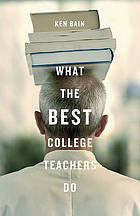 Bain, K. (2004). What the best college teachers do. Cambridge, Mass: Harvard University Press.
Bain, K. (2004). What the best college teachers do. Cambridge, Mass: Harvard University Press.
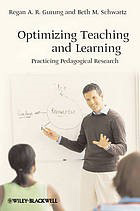 Gurung, R. A. R., & Schwartz, B. M. (2009). Optimizing teaching and learning: Practicing pedagogical research. Chichester, U.K: Wiley-Blackwell.
Gurung, R. A. R., & Schwartz, B. M. (2009). Optimizing teaching and learning: Practicing pedagogical research. Chichester, U.K: Wiley-Blackwell.
Less teaching, more learning: 10-yr study supports increasing student learning through less coverage and more inquiry; Luckie, D. B., Aubry, J. R., Marengo, B. J., Rivkin, A. M., Foos, L. A., & Maleszewski, J. J. (January 01, 2012). Advances in Physiology Education.
Undergraduate students' perspectives of essential instructor qualities; Trammell, B., & Aldrich, R. (February 26, 2016). Journal of the Scholarship of Teaching and Learning.
Support, belonging, motivation, and engagement in the college classroom: A mixed method study; Zumbrunn, S., McKim, C., Buhs, E., & Hawley, L. R. (September 01, 2014). Instructional Science: an International Journal of the Learning Sciences.
Books
 Bain, K. (2004). What the best college teachers do. Cambridge, Mass: Harvard University Press.
Bain, K. (2004). What the best college teachers do. Cambridge, Mass: Harvard University Press.
What makes a great teacher great? Who are the professors students remember long after graduation? This book, the conclusion of a fifteen-year study, offers valuable answers for all educators. The short answer is — it's not what teachers do, it's what they understand. Lesson plans and lecture notes matter less than the special way teachers comprehend the subject and value human learning. Whether historians or physicists, in El Paso or St. Paul, the best teachers know their subjects inside and out — but they also know how to engage and challenge students and to provoke impassioned responses. Most of all, they believe in two things: that teaching matters, and that students can learn. Ken Bain describes examples of ingenuity and compassion, of students' discoveries of new ideas and the depth of their own potential.
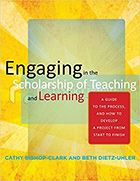 Bishop-Clark, C., & Dietz-Uhler, B. (2012). Engaging in the scholarship of teaching and learning: A guide to the process, and how to develop a project from start to finish.
Bishop-Clark, C., & Dietz-Uhler, B. (2012). Engaging in the scholarship of teaching and learning: A guide to the process, and how to develop a project from start to finish.
This guide provides prospective SoTL scholars with the necessary background information, foundational theory, tools, resources, and methodology to develop their own SoTL projects, taking the reader through the five stages of the process: generating a research question; designing the study; collecting the data; analyzing the data; and presenting and publishing your SoTL project. Each stage is illustrated by examples of actual SoTL studies and is accompanied by worksheets to help the reader refine ideas and map out his or her next steps. The process and worksheets are the fruit of the successful SoTL workshops the authors have offered at their institution for many years.
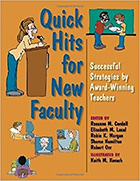 Cordell, R.M., Lucal, B., Morgan, R.K., Hamilton, S.J., & Orr, R. H. (2004). Quick hits for new faculty: Successful strategies by award winning teachers. Bloomington, IN: Indiana University Press.
Cordell, R.M., Lucal, B., Morgan, R.K., Hamilton, S.J., & Orr, R. H. (2004). Quick hits for new faculty: Successful strategies by award winning teachers. Bloomington, IN: Indiana University Press.
This is the third and latest book in the "Quick Hits" tradition of providing sound advice from award-winning college faculty. This volume is designed to help new faculty negotiate the challenges of college teaching. Articles and strategies range from planning for that first day in the classroom, to evaluating student learning, documenting teaching, and understanding the politics of teaching and learning in the department and institution. This volume expands each "quick hit" with additional background information, rationale, and resources.
 Gurung, R. A. R., & Schwartz, B. M. (2009). Optimizing teaching and learning: Practicing pedagogical research. Chichester, U.K: Wiley-Blackwell.
Gurung, R. A. R., & Schwartz, B. M. (2009). Optimizing teaching and learning: Practicing pedagogical research. Chichester, U.K: Wiley-Blackwell.
Optimizing Teaching and Learning will serve as a guide for anyone who is interested in improving their teaching and the learning of their students, and at the same time contribute to the scholarship of teaching and learning. It bridges the gap between the research and practice of SoTL, with explicit instructions on how to design, conduct, analyze, and write up pedagogical research, including samples of actual questionnaires and other materials (e.g., focus group questions) that will jumpstart investigations into teaching and learning. It also explores the advantages and disadvantages of various pedagogical practices and present applications of SoTL using case studies from a variety of disciplines. This book will serve as an invaluable resource for both seasoned faculty and new faculty who are just beginning to assess their teaching methods and learn how to think beyond the content.
Articles
Mere belonging: The power of social connections
Walton, G. M., Cohen, G. L., Cwir, D., & Spencer, S. J. (January 01, 2012). Mere belonging: The power of social connections. Journal of Personality and Social Psychology, 102, 3, 513-32.
"Four experiments examined the effect on achievement motivation of mere belonging, a minimal social connection to another person or group in a performance domain. Mere belonging was expected to increase motivation by creating socially shared goals around a performance task. … The results suggest that even minimal cues of social connectedness affect important aspects of self."
Multiple social identities and stereotype threat: Imbalance, accessibility, and working memory
Rydell, R. J., McConnell, A. R., & Beilock, S. L. (January 01, 2009). Multiple social identities and stereotype threat: Imbalance, accessibility, and working memory. Journal of Personality and Social Psychology, 96, 5, 949-66.
"In 4 experiments, the authors showed that concurrently making positive and negative self-relevant stereotypes available about performance in the same ability domain can eliminate stereotype threat effects. Replicating past work, the authors demonstrated that introducing negative stereotypes about women's math performance activated participants' female social identity and hurt their math performance (i.e., stereotype threat) by reducing working memory. Moving beyond past work, it was also demonstrated that concomitantly presenting a positive self-relevant stereotype (e.g., college students are good at math) increased the relative accessibility of females' college student identity and inhibited their gender identity, eliminating attendant working memory deficits and contingent math performance decrements."
Pedagogical perspectives for the online education skeptic
Brewer, P. E., & Brewer, E. C. (January 01, 2015). Pedagogical perspectives for the online education skeptic. Journal on Excellence in College Teaching, 26, 1, 29-52.
"While online programs continue to grow at an astounding rate in higher education, many faculty remain skeptical of the efficacy of online models. This article provides an overview of some significant benefits of online education while recognizing some common concerns. An examination of the current literature and the authors' own online experiences enable them to identify significant benefits in online education and suggest five foundational concepts for best practice."
Support, belonging, motivation, and engagement in the college classroom: A mixed method study
Zumbrunn, S., McKim, C., Buhs, E., & Hawley, L. R. (September 01, 2014). Support, belonging, motivation, and engagement in the college classroom: A mixed method study. Instructional Science: an International Journal of the Learning Sciences, 42, 5, 661-684.
"This explanatory sequential mixed methods study examined how belonging perceptions, academic motivation, and engagement might mediate the relationship between academic contextual characteristics and achievement using structural equation modeling and qualitative follow-up interviews with college students from a large, Midwestern university."
Yoo, J. H., Schallert, D. L., & Svinicki, M. D. (January 01, 2013). Effective teaching in an age of accountability: Mapping the views of college students and instructors. Journal on Excellence in College Teaching, 24, 4, 107-131.
"The authors captured students' and instructors' views of teaching effectiveness at the postsecondary level in two ways: open-ended questions delivered online to 500 students and one-on-one interviews with 15 instructors. A grounded theory approach suggested that effective teaching involves good communication aimed at helping students understand course concepts, strategies that engage students in learning, and a close monitoring of whether students are understanding, what they termed metacognitive teaching."
Hattie, J., & Timperley, H. (January 01, 2007). The power of feedback. Review of Educational Research, 77, 1, 81-112.
"Feedback is one of the most powerful influences on learning and achievement, but this impact can be either positive or negative. Its power is frequently mentioned in articles about learning and teaching, but surprisingly few recent studies have systematically investigated its meaning. This article provides a conceptual analysis of feedback and reviews the evidence related to its impact on learning and achievement. This evidence shows that although feedback is among the major influences, the type of feedback and the way it is given can be differentially effective."
The role of SoTL in the academy: Upon the 25th anniversary of Boyer's scholarship reconsidered
Kern, B., Mettetal, G., Dixson, M., & Morgan, R. (2015). The role of SoTL in the academy: Upon the 25th anniversary of Boyer's scholarship reconsidered. Journal of the Scholarship of Teaching and Learning, 15, 3, 1-14.
"This essay works toward two goals: 1) to provide an explanation of how the Scholarship of Teaching and Learning may work within all four of Boyer's 'scholarships' of discovery, integration, application, and teaching and 2) to clarify the distinctions between quality teaching and scholarship of teaching and learning research."
Linvill, D. (January 01, 2011). The relationship between student identity development and the perception of political bias in the college classroom. College Teaching, 59, 2, 49-55.
"This study explored the relationship between identity development, as gauged by Marcia's identity development construct, and student perception of instructor political bias. Regression analysis was employed to compare participant responses on the Ego Identity Process Questionnaire, a measure of Marcia's construct, with the Political Bias in the Classroom Survey, a measure gauging perceptions of and reactions to instructor political bias. The EIPQ's commitment scale was found to be a significant positive indicator for the PBCS's perception scale, suggesting that students who are strongly committed to their identity are more likely to perceive an instructor as having a political bias. Recommendations are made for how to address perceptions of political bias."
Luckie, D. B., Aubry, J. R., Marengo, B. J., Rivkin, A. M., Foos, L. A., & Maleszewski, J. J. (January 01, 2012). Less teaching, more learning: 10-yr study supports increasing student learning through less coverage and more inquiry. Advances in Physiology Education, 36, 4, 325-35.
"In this study, we compared gains in student content learning over a 10-yr period in which the introductory biology laboratory curriculum was changed in two ways: an increase of inquiry and a reduction of content."
Undergraduate students' perspectives of essential instructor qualities
Trammell, B., & Aldrich, R. (February 26, 2016). Undergraduate students' perspectives of essential instructor qualities. Journal of the Scholarship of Teaching and Learning, 16, 1, 15.
"There are many variables that impact a classroom experience including the instructor, the student, and the class itself. Much research has been done in the area of undergraduate student expectations and preferences for instructors, course format, etc. This paper explores how specific student characteristics such as first-generation status, age, class level, and format impact students' perception of what makes a good instructor."